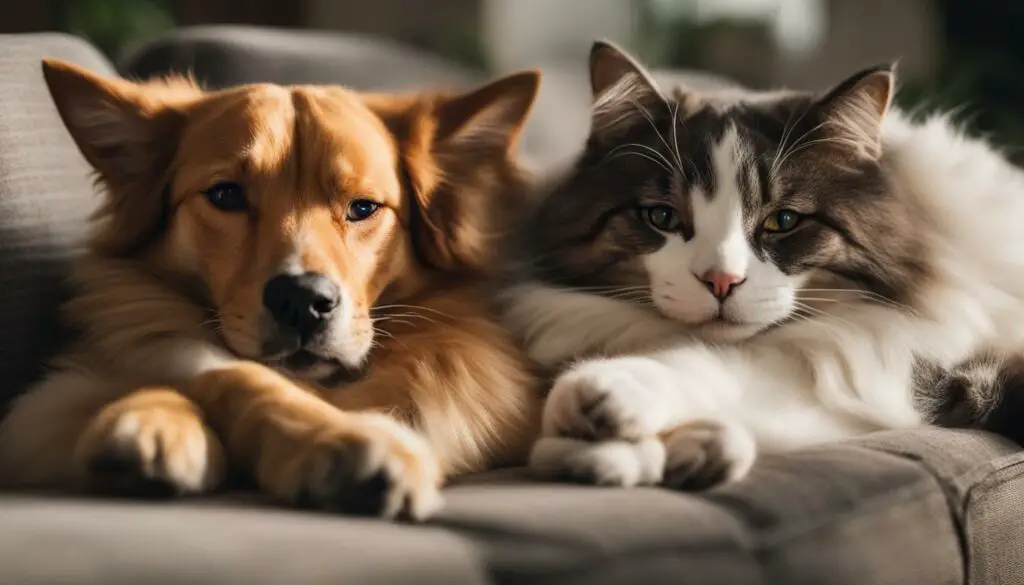Cats and dogs have always fascinated me with their unique bond and affectionate connection. As a pet owner, I often wonder why my cat loves my dog so much. What is it about their relationship that makes them inseparable? In this article, we will delve into the dynamics of this cat-dog bond and explore the reasons behind their deep affection and strong friendship.
Key Takeaways:
- Cats and dogs can form deep bonds based on trust and companionship.
- A comfortable environment is crucial for a harmonious cat-dog relationship.
- Gradual introductions, scent exploration, and positive reinforcement are key in fostering a strong bond between them.
- Understanding your cat’s behavior and providing them with space and security is vital.
- Consulting a veterinarian is important if you notice any significant changes in your cat’s behavior or signs of stress.
Creating a Comfortable Environment for Your Cat
When it comes to fostering a harmonious cat-dog relationship, creating a comfortable environment for your cat is crucial. Cats thrive in a calm and secure space where they can feel safe and retreat to when needed. By providing a designated sanctuary for your cat, you can help alleviate stress and promote a drama-free household.
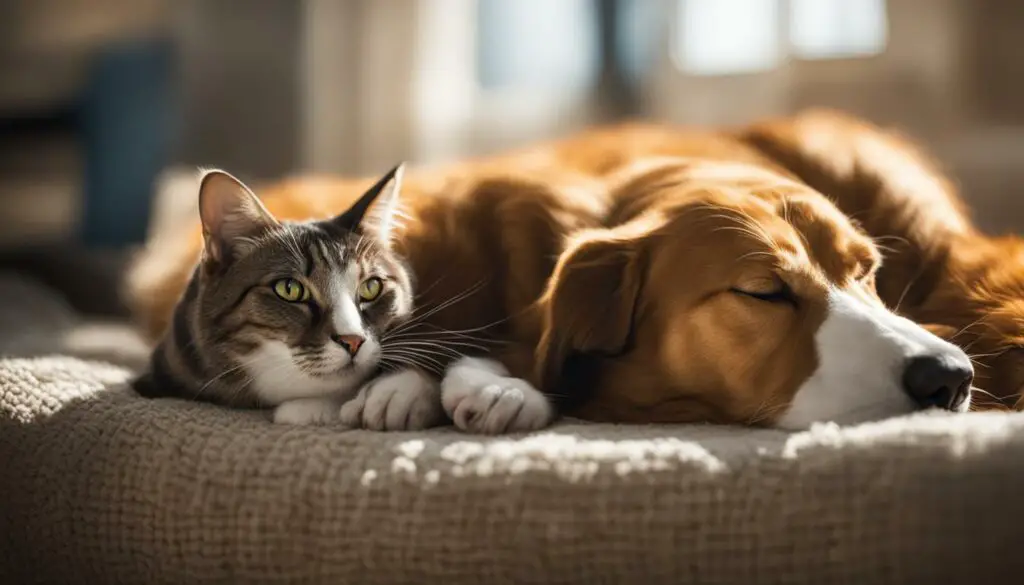
In the cat’s sanctuary, ensure you include all their essential needs such as a litter box, toys, and food and water bowls. This will not only make your cat feel more at ease but also establish a sense of ownership and territory. By having a separate space specifically designed for your cat, you are giving them the autonomy they need while still allowing them to interact with your dog when they feel comfortable.
Additionally, consider providing vertical spaces such as cat trees or shelves where your cat can perch and observe their surroundings from a safe distance. This will allow them to feel in control and avoid potential confrontations with your dog. Creating a comfortable environment for your cat is an essential step in fostering a positive and harmonious cat-dog relationship.
Section 3: Maintaining Control of Your Dog
When it comes to the cat-dog relationship, it’s important to consider the territorial nature of dogs. While your cat may love your dog, it’s vital to establish boundaries and maintain control over your canine companion. This will help ensure a harmonious and safe environment for both pets.
One effective way to maintain control is by using a leash. By keeping your dog on a leash during interactions with your cat, you can prevent any sudden or aggressive behaviors. This allows your cat to feel more secure and reduces the risk of any potential harm.
In addition to using a leash, dog obedience training can be incredibly beneficial. By training your dog to respond to commands and redirecting their hunting instincts, you can create a more calm and controlled environment for your cat. Positive reinforcement techniques during training sessions can help reinforce desirable behaviors and discourage any negative interactions between your pets.
Walking Your Dog
Regular walks provide an excellent opportunity to reinforce your dog’s training and further establish control. During walks, focus on maintaining your dog’s attention and reinforcing their obedience. This will not only help with their overall behavior but also contribute to a more balanced and respectful relationship with your cat.
Remember, establishing and maintaining control over your dog is crucial for ensuring the safety and well-being of both your pets. By using a leash, providing obedience training, and reinforcing positive behaviors, you can create a peaceful environment where your cat and dog can coexist happily.
| Benefits of Maintaining Control | Methods to Maintain Control |
|---|---|
| Prevents potential harm to your cat | Use a leash during interactions |
| Reduces stress and anxiety for both pets | Implement dog obedience training |
| Creates a calm and controlled environment | Reinforce positive behaviors through training |
Step-by-Step Introduction Process
Introducing cats and dogs requires a gradual step-by-step process to ensure a smooth and successful transition. Here is a guide to help you introduce your pets:
- Keep them separated initially: Start by keeping your cat and dog in separate areas of the house for a few days. This allows them to become familiar with each other’s scent without direct contact. This step is crucial to prevent any immediate confrontations and reduce stress.
- Encourage scent exploration: After a few days, you can start introducing their scents to each other. Swap their bedding or use a cloth to rub their scent on and allow each pet to sniff it. This helps them become accustomed to each other’s smell and creates a positive association.
- Arrange a face-to-face meeting: Once they have become familiar with each other’s scent, it’s time for a supervised face-to-face meeting. Keep both pets on a leash or have a physical barrier between them initially. This allows them to see and observe each other without direct contact. Use treats and positive reinforcement to reward calm behavior during this meeting.
It’s important to be patient during this process as it may take several weeks or more for your pets to feel comfortable around each other. Each pet’s personality and previous experiences will influence the pace of the introduction. By following these steps and providing a positive and controlled environment, you are giving your cat and dog the best chance to form a harmonious relationship.
Testimonials:
“I followed the step-by-step introduction process, and now my cat and dog are the best of friends! It took some time, but the gradual approach really made a difference in their relationship.” – Sarah, pet owner
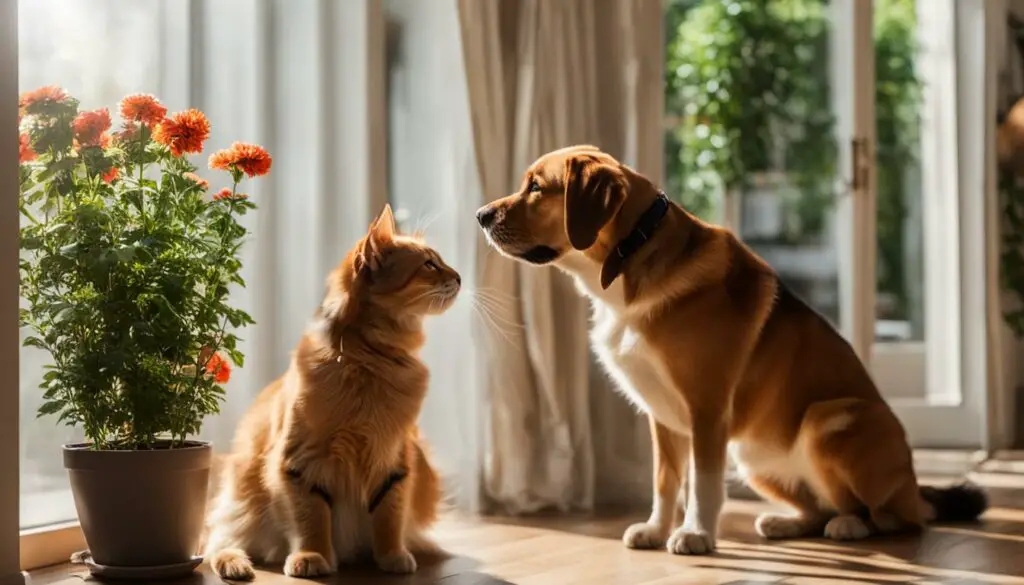
| Common Challenges During Introductions: | How to Address Them: |
|---|---|
| Fear or Aggression | Consult with a professional trainer or behaviorist for guidance on managing and modifying aggressive behavior. |
| Unwanted Chasing or Prey Drive | Continue training and obedience exercises with your dog to redirect their hunting instincts. Reward calm behavior and discourage chasing or aggressive behavior towards the cat. |
| Stress or Anxiety | Ensure that both pets have their own spaces where they can retreat and feel safe. Provide plenty of environmental enrichment and mental stimulation to help reduce stress. |
Remember, every pet is unique, and the introduction process may vary depending on their individual personalities and past experiences. Take the time to observe and understand their behavior, and make adjustments accordingly. With patience and positive reinforcement, your cat and dog can form a strong and loving bond.
Allowing Interactions and Building Trust
Once initial introductions have been successful, it is important to encourage interactions between your cat and dog while providing constant supervision. This allows them to further develop their bond and trust in each other. Positive reinforcement through treats and rewards can also play a vital role in strengthening their relationship.
During their interactions, observe their body language closely. Look for signs of comfort and enjoyment, such as relaxed postures, playfulness, and gentle interactions. If any signs of tension or aggression arise, immediately separate the pets and consult a professional trainer or behaviorist for guidance.
Remember, building trust takes time, so be patient. Allow your cat and dog to gradually spend more time together, always ensuring their safety. Provide them with plenty of positive experiences together, such as supervised play sessions or joint activities, to reinforce their positive associations with each other.
Creating a Trust-Building Routine
- Set aside dedicated playtime for your cat and dog to enjoy together, using interactive toys to engage them in joint activities.
- Establish a consistent daily routine for feeding and exercise, ensuring that your pets feel secure and know what to expect.
- Offer individual attention and affection to each pet, reinforcing their importance within the household.
- Gradually increase the duration and frequency of their interactions as they become more comfortable with each other.
By following these steps and providing a positive and structured environment, you can foster a strong and harmonious relationship between your cat and dog. Remember, every pet is unique, and their comfort levels may vary. It is crucial to respect their individual boundaries and preferences throughout the trust-building process.
| Benefits of Allowing Interactions and Building Trust |
|
|---|
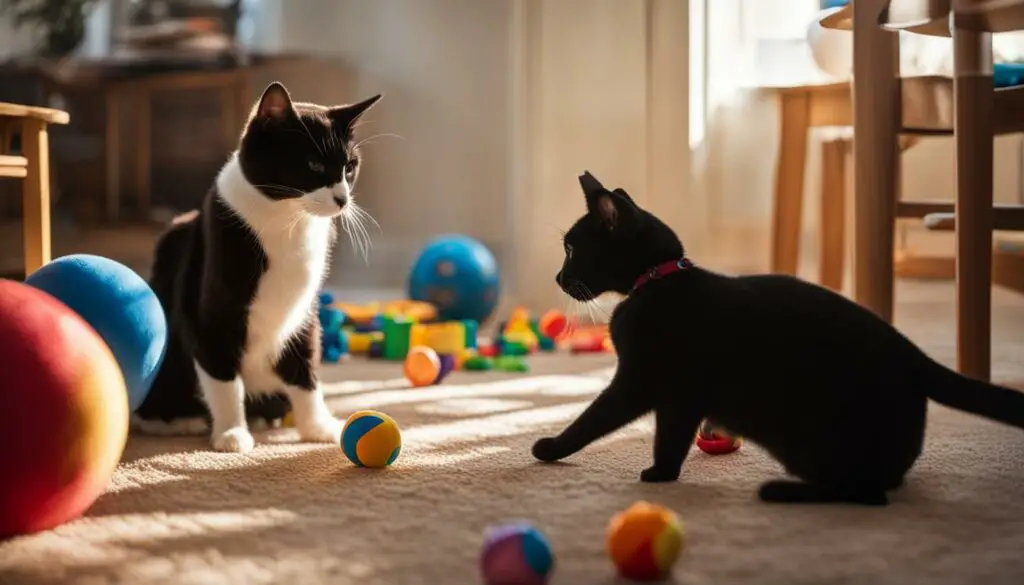
“The more positive experiences they have together, the stronger their bond will become.”
Providing Separate Spaces
Creating separate spaces for your cat and dog is essential for maintaining a harmonious household. While they may have developed a close bond, it’s important to respect their individual needs and provide them with their own territories. Your cat should have a dedicated sanctuary, a place where they can retreat to and feel safe.
Having a cat’s sanctuary ensures that they have a space where they can relax and have alone time. This area should include their essential needs such as a comfortable bed, litter box, toys, and food and water bowls. It’s important to make sure that this space is dog-free to prevent any potential conflicts or disruptions.
By providing separate spaces, you are giving your cat the opportunity to have some alone time and maintain their independence. This helps reduce stress and allows them to recharge before engaging in interactions with your dog. It also helps prevent territorial conflicts and ensures a peaceful coexistence between your cat and dog.
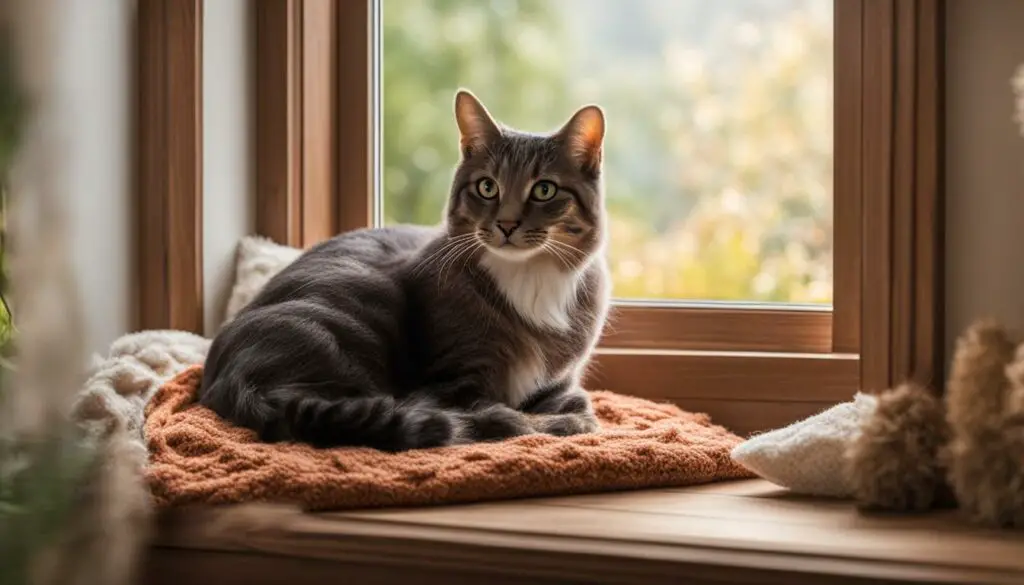
The Importance of Cat’s Sanctuary
A cat’s sanctuary is crucial for their well-being. It provides them with a sense of security, allowing them to feel safe and comfortable in their own space. This reduces their stress levels and promotes a positive mental state. It also gives your cat a place where they can retreat to if they ever feel overwhelmed or need some time alone.
Creating a cat’s sanctuary is relatively easy. Choose a quiet corner or room in your home where your cat can have some privacy. Make sure to include all their essential needs, such as a cozy bed, litter box, scratching post, and toys. You can also add some calming elements, like a soft blanket or pheromone diffuser, to enhance the relaxing environment.
| Benefits of Providing Separate Spaces | Benefits of Cat’s Sanctuary |
|---|---|
|
|
“Creating separate spaces for your cat and dog not only ensures a peaceful coexistence but also promotes their individual well-being. It allows your cat to have some alone time and maintain their independence while providing a safe and secure environment. By respecting their need for separate spaces, you are nurturing a harmonious relationship between your cat and dog.”
Understanding the Importance of Warmth
When it comes to the close bond between cats and dogs, one fascinating aspect is the cat’s desire for warmth. Cats are naturally drawn to warmth, and one of the reasons they may choose to lay on your dog is to seek that additional warmth. The chest and face of a dog are particularly warm areas of the body, making them desirable spots for a cat seeking comfort and security.
This instinctive behavior showcases the cat’s need for body heat and their resourcefulness in finding a cozy spot. By providing this warmth, your dog becomes a natural and reliable source of comfort for your cat. It’s a heartwarming display of their relationship and the trust they have in each other’s presence.
Understanding the importance of warmth in the cat-dog bond can help you further nurture their relationship. By providing a comfortable environment and ensuring your pets have access to warm spaces, you can create an atmosphere that promotes their well-being and strengthens their connection.
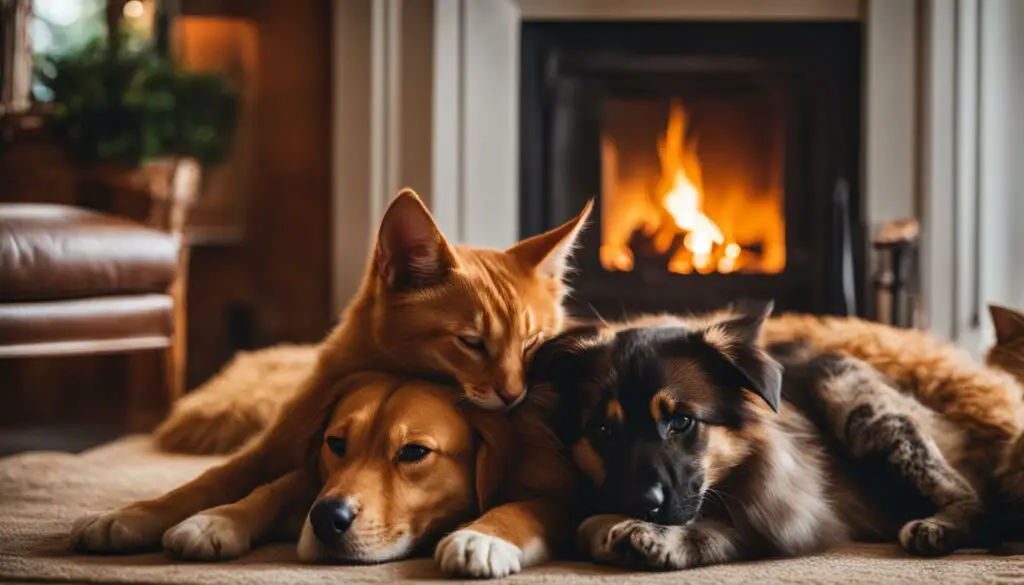
Creating a Warm and Cozy Space
Make sure your home has areas where your cat and dog can cozy up together. Provide soft bedding or blankets in a warm corner for them to share. This will not only satisfy the cat’s need for warmth but also encourage their bond to grow stronger.
Monitoring Body Temperature
Keep a close eye on both your cat and dog’s body temperature, especially during colder months. Ensure they are not exposed to extreme cold or heat, as this can be detrimental to their health. By maintaining a comfortable temperature in your home and providing additional sources of warmth, you can keep them both content and snug.
Spending Quality Time Together
Encourage quality bonding time between your cat and dog. Engage them in activities they both enjoy, such as playtime or gentle grooming sessions. This shared experience not only provides warmth but also strengthens their emotional connection and fosters a sense of security.
Listening to Your Heartbeat
When your cat curls up on your chest and listens to your heartbeat, it is seeking familiar comfort and reassurance. Cats have a natural affinity for the sound of their owner’s heartbeat, which reminds them of the rhythmic sound they heard as kittens when snuggling up against their mother’s belly. This behavior not only provides your cat with a sense of security but also strengthens the bond between you and your feline companion.
The soothing and steady rhythm of your heartbeat can have a calming effect on your cat. It creates a sense of familiarity and safety, as they associate your presence with warmth and comfort. The vibrations produced by your heartbeat may even have therapeutic effects, promoting relaxation and reducing stress for both you and your cat.
I often find my cat nestled against my chest, listening to my heartbeat. It’s a special moment that reminds me of the deep connection we share.
By allowing your cat to rest on your chest and listen to your heartbeat, you are providing them with the reassurance they need to feel safe and secure. It is a comforting gesture that strengthens the bond between you and your feline friend. So, next time your cat chooses to snuggle up against you, take a moment to appreciate the comforting connection you both share.
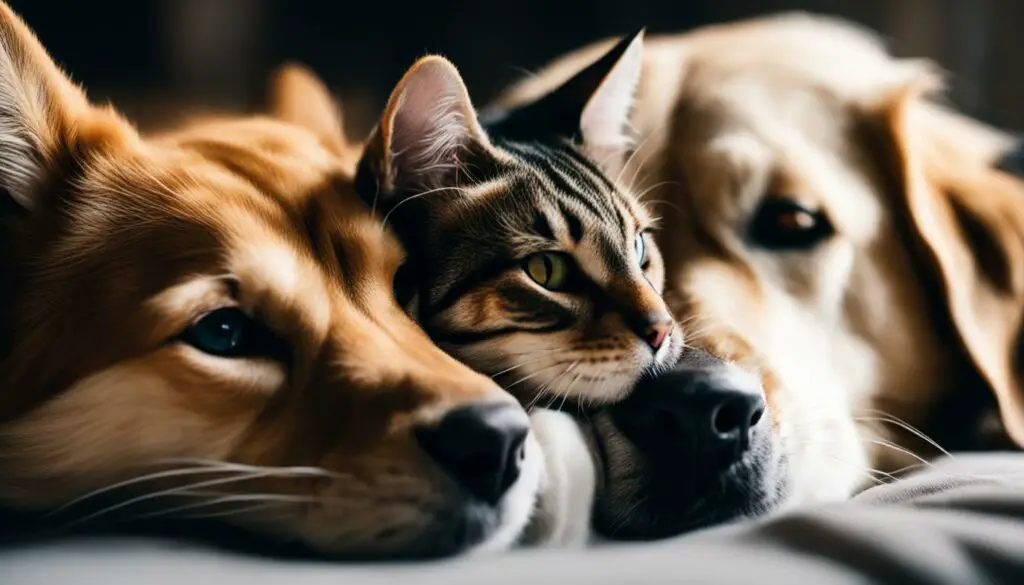
Marking Territory and Establishing Ownership
One intriguing behavior that cats display towards their owners is marking with scent. By rubbing their cheek against you, your cat is leaving behind their pheromones as a way to mark their territory and establish ownership. This behavior is deeply rooted in their instinctual need to claim their environment and communicate with other animals in the area.
Through scent marking, cats create a sense of familiarity and security. By marking you with their scent, your cat is signaling to other animals that you are part of their territory, reinforcing the bond between you and your feline friend. It’s their way of saying, “You belong to me, and I belong to you.”
This behavior can be seen as a sign of affection and trust. By marking you, your cat is expressing their comfort and contentment in your presence. It’s a way for them to show their attachment and reinforce the positive connection they feel towards you. So, the next time your cat rubs against your leg or nuzzles their face against yours, take it as a compliment and a clear sign that you are an important part of their world.
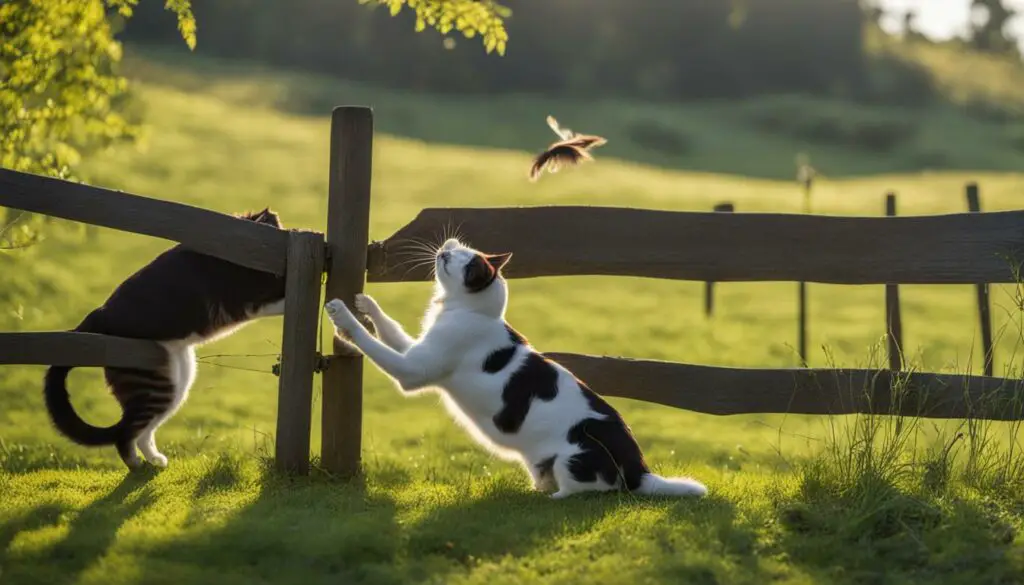
The Importance of Providing Marking Opportunities
To foster a healthy and fulfilled cat-dog relationship, it’s crucial to provide opportunities for marking and scent exploration. By providing scratching posts, vertical spaces, and interactive toys, you can encourage your cat to mark their territory in appropriate ways. This not only helps them feel a sense of ownership but also provides mental stimulation and satisfies their natural instincts.
Additionally, it’s important to recognize and respect your cat’s need for personal space. Allow them to establish their own territory by providing them with a dedicated safe space, such as a cozy bed or a secluded area in your home. This will give them a sense of security and control over their surroundings, further enhancing the bond they share with you and your dog.
| Benefits of Marking with Scent | Importance of Providing Marking Opportunities |
|---|---|
| 1. Establishes territory | 1. Fosters a healthy relationship |
| 2. Reinforces the bond between cat and owner | 2. Provides mental stimulation |
| 3. Signals comfort and contentment | 3. Satisfies natural instincts |
| 4. Creates a sense of familiarity and security | 4. Enhances the bond between cat, owner, and dog |
Seeking Protection and Security
When your cat cuddles up to your dog, it is seeking a sense of protection and security. Cats are instinctively drawn to their owners as a source of safety, and your dog plays a crucial role in fulfilling that need. Your dog’s presence creates a comforting environment for your cat, allowing them to feel safe and secure in your home.
Whether it’s the size and strength of your dog or the bond they have formed with your cat, the presence of a canine companion provides a sense of reassurance for your feline friend. Cats rely on their owners for protection, and by seeking closeness with your dog, they are reaffirming the trust and bond they have with you.
The feeling of security that your cat experiences when snuggling up to your dog can also be attributed to the calming presence and warmth that your dog provides. Your cat may find solace in the steady rhythm of your dog’s breathing and the soothing sound of their heartbeat. This physical contact with your dog brings comfort and a sense of familiar companionship to your cat.
Overall, the act of seeking protection and security through cuddling with your dog is a natural behavior for your cat. It highlights the deep bond and trust they have developed with both you and your canine companion. By providing a safe and nurturing environment, you can foster a strong relationship between your cat and dog that brings them both comfort and joy.
| Reasons why cats seek protection and security from dogs: |
|---|
| The presence of a dog provides a sense of safety and protection for cats |
| Cats instinctively rely on their owners for security |
| The physical contact with a dog brings comfort and familiarity to cats |
Stress and Anxiety Indicators
Stress and anxiety can manifest in various ways in cats, and it’s important for pet owners to recognize the indicators. Changes in behavior can be a clear sign that your cat is experiencing stress. Some common behavior changes include increased vocalization, aggression, excessive grooming, and avoidance of social interaction. It’s crucial to pay attention to these signs and take appropriate measures to address your cat’s well-being.
One of the key indicators of stress in cats is a change in their sleeping patterns. If your cat starts laying on your dog suddenly, it could be a sign of stress or anxiety. Cats seek comfort and security in their environment, and by cuddling up to your dog, they may be seeking reassurance and a sense of safety.
Another indicator of stress is excessive meowing or attention-seeking behavior. Cats may become more demanding for affection and may constantly follow their owners around. These behaviors can be a cry for help, signaling that they are feeling stressed and in need of comfort and reassurance.
Remember, every cat is unique, and their response to stress may vary. It’s essential to observe your cat’s behavior closely and consult with a veterinarian if you have concerns about their well-being. A professional can provide guidance and help you develop strategies to alleviate stress and promote a harmonious environment for your cat and dog.
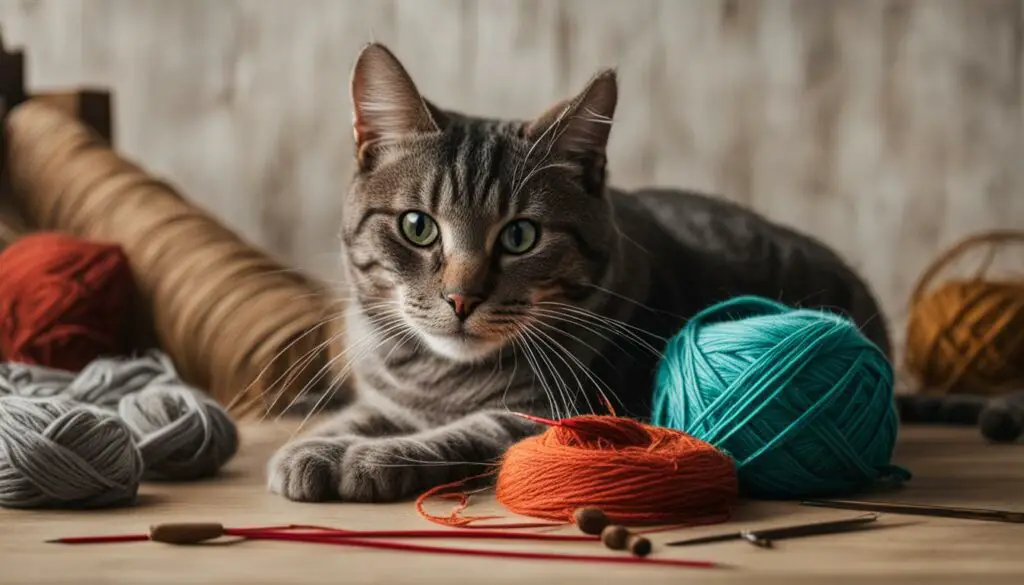
Recognizing and Addressing Stress in Cats
Recognizing stress and anxiety in your cat is the first step towards addressing their well-being. It’s important to create a calm and secure environment for your feline companion. Providing hiding spots, vertical spaces, and interactive toys can help reduce stress levels. Additionally, maintaining a consistent routine and providing mental and physical stimulation can contribute to your cat’s overall well-being.
In cases where stress is severe or persistent, it may be necessary to consult with a veterinarian. The veterinarian can conduct a thorough examination to rule out any underlying medical conditions and recommend appropriate treatment options. They may also suggest behavioral modification techniques or prescribe medications to help manage your cat’s stress.
Remember, stress is a normal response for cats, but it’s essential to address it promptly to prevent long-term health issues. By understanding the indicators of stress and taking steps to alleviate it, you can create a harmonious and peaceful environment for your cat and dog.
Benefits of Cats Sleeping on Your Chest
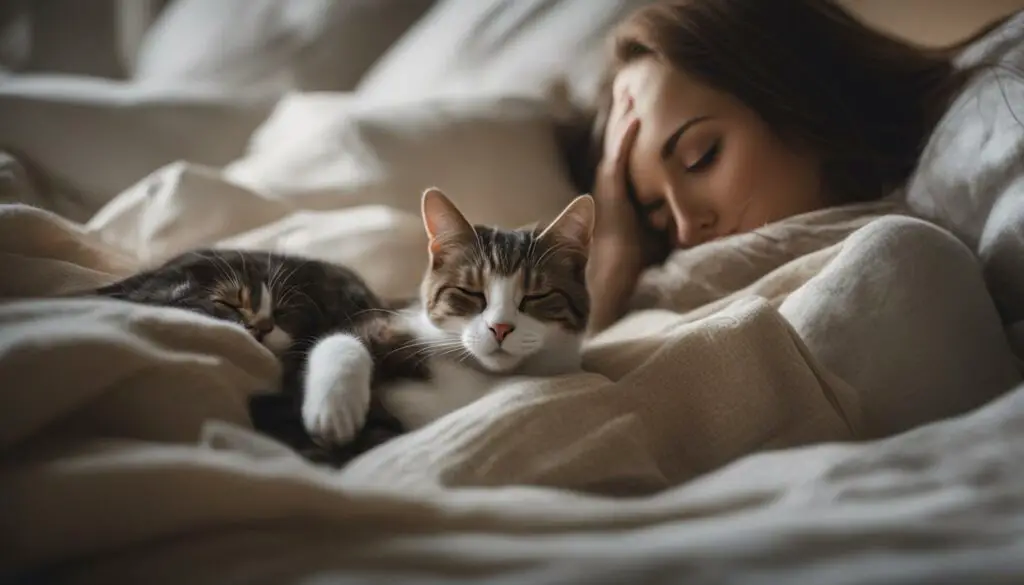
One of the most endearing behaviors of cats is their tendency to sleep on their owners’ chests. While this may seem like a simple act of comfort-seeking, there are actually several benefits to allowing your cat to curl up on your chest for a snooze.
The Soothing Sound of a Purr
When a cat settles on your chest, their gentle purring can create a soothing ambiance. The rhythmic sound and vibrations of their purr have been shown to have stress-reducing effects on humans. It can induce a sense of calm and relaxation, helping to alleviate anxiety and promote a peaceful state of mind.
A Therapeutic Presence
Having a cat sleep on your chest can be a therapeutic experience. The feeling of their warm body nestled against you can provide a sense of comfort and companionship. This physical closeness releases oxytocin, often referred to as the “love hormone,” which enhances feelings of happiness and bonding.
A Mutual Connection
Allowing your cat to sleep on your chest strengthens the bond between you and your feline friend. It creates a sense of trust and security, as your cat feels safe and protected in your presence. This bonding experience can be invaluable, deepening the emotional connection you share with your furry companion.
In conclusion, the act of a cat sleeping on your chest is not only adorable but also has numerous benefits. From the soothing sound of their purr to the therapeutic presence they provide, this simple act can enhance your well-being and strengthen the bond between you and your cat.
Establishing Boundaries and Alternatives
When your cat’s behavior of sleeping on your dog becomes disruptive, it’s important to establish boundaries to ensure a peaceful coexistence in your home. Providing your cat with their own cozy bed in a warm and elevated location can encourage them to sleep elsewhere. This creates a designated sleeping area for your cat, reducing any disturbances caused by their presence on your dog.
Positive reinforcement is key in helping your cat understand and comply with these boundaries. Whenever your cat chooses to sleep in their own bed instead of on your dog, reward them with treats or praise. This positive reinforcement will reinforce the desired behavior and encourage your cat to continue using their own bed.
Remember, it may take some time for your cat to adjust to the new sleeping arrangements. Be patient and consistent with the boundaries you set. Eventually, your cat will learn to enjoy their own bed and understand that it is their designated sleeping area.
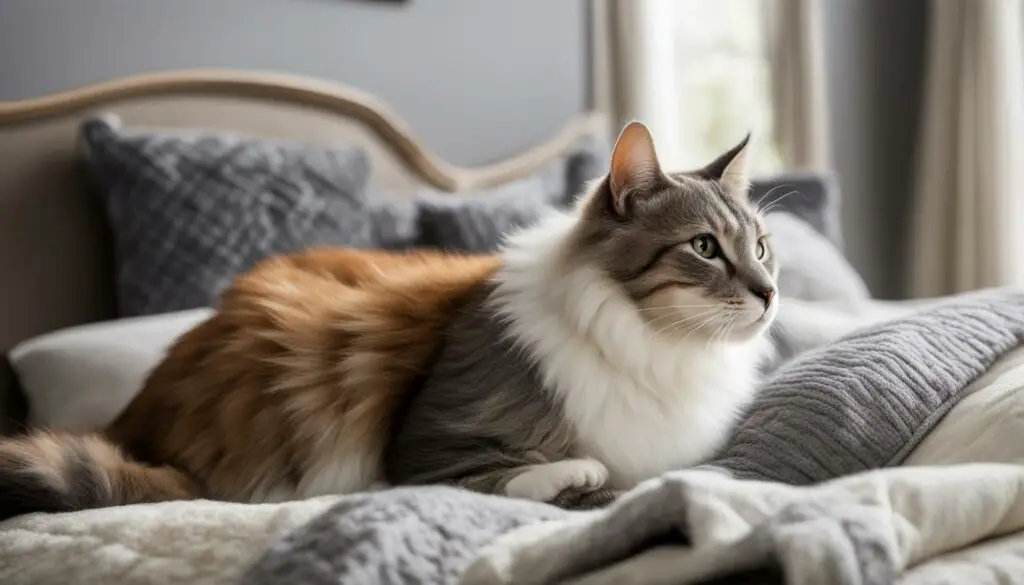
Frequently Asked Questions
- Q: What if my cat refuses to sleep in their own bed?
- Q: Can I still allow my cat to sleep on my dog occasionally?
- Q: What if my cat starts sleeping on my dog again after using their own bed?
A: If your cat is resistant to using their own bed, try placing items with familiar scents, such as a blanket or toy, in the bed to make it more inviting. You can also try relocating the bed to a different area of your home to see if your cat prefers a different sleeping spot.
A: It is okay to allow occasional interactions between your cat and dog, as long as both animals are comfortable and there are no signs of stress or aggression. However, it is important to maintain the boundaries you have established and encourage your cat to primarily use their own bed.
A: If your cat reverts to sleeping on your dog, it may be a sign that they are seeking additional warmth or comfort. Ensure that their own bed is warm and cozy enough to compete with the appeal of sleeping on your dog. You may also consider providing alternative sources of warmth, such as a heated pet bed or a blanket.
Consulting a Veterinarian
If you notice significant changes in your cat’s behavior or signs of stress, it is crucial to consult a veterinarian. They are trained professionals who can assess your cat’s health and provide guidance on how to address any underlying issues. A veterinarian can offer valuable insights and solutions to ensure your cat’s well-being and improve their relationship with your dog.
Behavior changes in cats can be indicators of stress or underlying health problems. These changes can manifest in various ways, such as increased aggression, excessive grooming, loss of appetite, or withdrawal from social interactions. It is essential to pay attention to these signs and consult a veterinarian promptly.
“Seeking professional advice from a veterinarian is the best course of action when dealing with a stressed cat,” says Dr. Sarah Thompson, a renowned veterinarian. “They can conduct a thorough examination, run tests if necessary, and help you understand the root causes of your cat’s behavior changes. Veterinary professionals can also provide recommendations on behavioral training techniques or prescribe medication if needed.”
Remember, your veterinarian is your ally in ensuring the well-being of your cat. By seeking their expert advice, you can gain a better understanding of your cat’s stressors and receive tailored recommendations on how to alleviate their anxiety. Don’t hesitate to reach out to a veterinarian for support and guidance.
How a Veterinarian Can Help:
- Evaluate your cat’s health and behavior
- Identify underlying causes of stress or behavior changes
- Provide recommendations for managing your cat’s stress
- Suggest training techniques or medications, if necessary
- Offer guidance on creating a cat-friendly environment
| Signs of Stress in Cats | Ways a Veterinarian Can Help |
|---|---|
| Increased aggression | Behavioral analysis and training recommendations |
| Excessive grooming or self-mutilation | Assessment for underlying medical conditions and potential treatment options |
| Loss of appetite or weight loss | Physical examination, diagnostic tests, and dietary recommendations |
| Withdrawal from social interactions | Behavioral evaluation and suggestions for creating a stress-free environment |
When it comes to your cat’s well-being, seeking professional help is always a wise decision. Remember, a veterinarian has the expertise and knowledge to assess your cat’s unique situation and provide the necessary support to improve their overall quality of life.
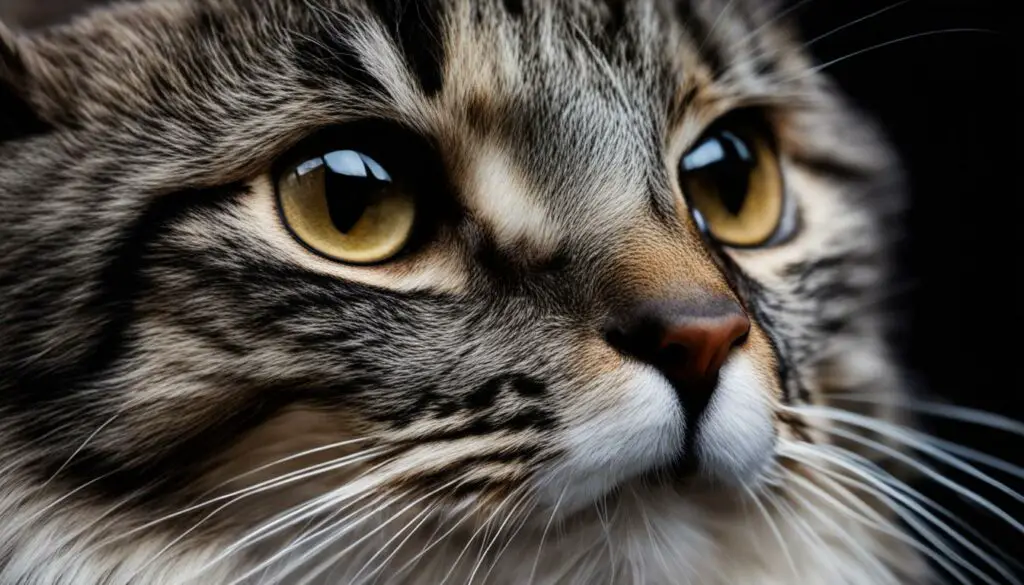
Conclusion
Throughout this article, we have explored the love, bonds, and mutual understanding that can develop in the unique cat-dog relationship. Despite being different species, cats and dogs have the capacity to form deep connections based on trust, companionship, and respect.
By creating a comfortable environment for your cat and establishing boundaries for your dog, you can set the stage for a harmonious household. Gradual introductions, positive reinforcement, and constant supervision are crucial in allowing the cat and dog to interact and build trust over time.
It is important to recognize the individual needs of your cat and provide them with their own sanctuary. This will allow them to have alone time and maintain their sense of territory. Additionally, understanding the reasons behind certain behaviors, such as seeking warmth or listening to your heartbeat, can deepen your bond with your cat.
If you notice any signs of stress or significant changes in your cat’s behavior, consulting a veterinarian is essential. They can provide guidance on addressing any underlying issues and ensuring the well-being of your cat.
The love between cats and dogs is truly heartwarming. By nurturing their relationship with care and compassion, you can create a beautiful bond between your beloved pets that will bring joy and happiness to your home.
FAQ
Why does my cat love my dog so much?
Cats and dogs can form deep bonds based on trust, companionship, and mutual understanding.
How can I create a comfortable environment for my cat?
Provide a separate space where your cat can retreat to and feel safe, with their essential needs such as a litter box, toys, and food and water bowls.
How can I maintain control of my dog?
Use a leash or other restraints to keep your dog under control, and consider prior obedience training to redirect hunting instincts and prevent aggressive behavior towards cats.
What is the step-by-step introduction process for cats and dogs?
Keep them separated for a few days to allow familiarity without direct contact, encourage scent exploration by letting each pet sniff the belongings of the other, and arrange a face-to-face meeting with supervision, using treats as positive reinforcement for good behavior.
How can I allow interactions and build trust between my cat and dog?
Provide constant supervision during interactions, use treats and rewards for positive reinforcement, and be patient as it can take time for the pets to feel comfortable around each other.
Why is it important to provide separate spaces for cats and dogs?
Cats should always have access to their sanctuary, a dog-free area where they can find solace and have alone time, to reduce the potential for territorial conflicts.
Why does my cat like to lay on my dog?
Cats are naturally drawn to warmth, and your dog’s chest and face are particularly warm areas of the body, making them desirable spots for a cat seeking comfort and security.
Why does my cat like to listen to my heartbeat?
Cats have a natural affinity for their owner’s heartbeat, and by resting on your chest and listening to your heartbeat, your cat is seeking reassurance and finding security in your presence.
Why does my cat rub their cheek against me?
Cats use scent to mark their territory, and by rubbing their cheek against you, your cat is marking you with their scent and establishing ownership.
Why does my cat cuddle up to my dog?
Cats instinctively seek protection and security from their owners, and by cuddling up to your dog, your cat is seeking the safety and comfort that your presence provides. Your dog acts as a protector and creates a sense of security for your cat, further strengthening their bond.
What should I do if my cat’s behavior changes or shows signs of stress?
It is important to consult a veterinarian to assess your cat’s health and address any underlying issues causing stress or anxiety.
What are the benefits of cats sleeping on your chest?
A cat’s purr has been shown to reduce stress and have therapeutic effects on humans. The rhythmic sound and vibrations can create a calming effect, promoting relaxation and a sense of well-being.
How can I establish boundaries and provide alternatives for my cat’s sleeping habits?
Provide your cat with their own cozy bed in a warm and elevated location, and use positive reinforcement and rewards for using their bed to encourage them to sleep elsewhere.
Should I consult a veterinarian if my cat’s behavior changes?
Yes, if you notice significant changes in your cat’s behavior or signs of stress, it is important to consult a veterinarian for guidance and solutions to ensure your cat’s well-being and improve their relationship with your dog.

